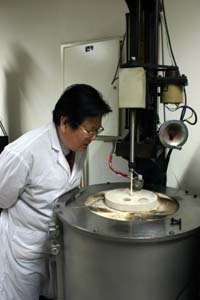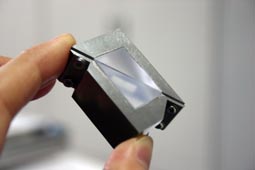

A Sino-Japanese research team has succeeded in observing the superconducting electron directly by the photoemission spectroscopy with the highest resolution (360 µeV) of the world. With the achievements, the researchers say, they will be able to solve problems regarding the exotic superconducting mechanism.
The group is composed of Prof. CHEN Chuangtian with the CAS Institute of Physics and Chemistry and Prof. XU Zuyan with the CAS Institute of Physics from China, and Prof. Shik SHIN and Prof. Shuntaro WATANABE with the Institute for Solid State Physics, The University of Tokyo, and Dr. Takayuki KISS with the Institute of Physical and Chemical Research (RIKEN) from Japan. Their work has been published in Vol.94 of the
Physical Review Letters (2005).
Photoelectric effect is a phenomenon that the electron comes out when the solid is irradiated by the light. This effect is caused only by the ultraviolet light, not but the visible light. Einstein published five important papers including photoelectric effect in 1905, and later on he won the Nobel Prize because the photoelectric effect proves that light is a quantum. Photoemission is the experimental method to measure the electrons in the solids directly. Some cutting edge basic research on issues like semiconductors, superconductors and magnetism has been based on the photoemission spectroscopy. The applications of photoemission process have also been significant in the high technology such as charge-coupled devices (CCD).
The Sino-Japanese team has come up with a completely new photoemission experimental method by the combination of Japanese photoemission technique and the laser technique jointly developed by Japanese and Chinese researchers. By using this experimental method, they obtained an extraordinary high resolution of 360 µeV, which enable the researchers to investigate the exotic superconducting mechanism for the first time.
The quasi-CW laser is essentially necessary in vacuum ultraviolet light region in order to carry out the high-resolution photoemission spectroscopy. But until recently there have been no such laser light. Therefore, Chen's group has developed the optical special crystal (KBBF) and the prism-nonlinear optical crystal coupling technique and Watanabe's group has developed the laser system using this crystal. Finally the team obtained the highest photon energy of 6.994 eV (177.3 nm) for the first time.
By the ultrahigh resolution, the researchers can make clear the solid state properties in detail. For example, the energy of the superconducting electron of exotic superconductor is below 1meV. However, they have not been able to observe the superconducting electrons of exotic superconductors, because such photoelectron resolution has not been obtained. Therefore, scientists in the world are aiming at the 1meV resolution. In this study, the Sino-Japanese team has succeeded in reaching the highest resolution of up to 360 µeV that is below 1meV for the first time.
In this work, the team observed the superconducting electrons of CeRu2 directly for the first time whose superconducting mechanism has not been known. Consequently, they found this material has the exotic superconducting mechanism that could not be elucidated by the ordinary simple superconducting theory (BCS theory). With the result, the scientists will be able to proceed to the materials design for the new superconductors that have much higher superconducting transition temperature.
Contact persons:
Prof. Chuangtian CHEN, Chinese Academy of Science, China, cct@cl.cryo.ac.cn
Prof. Shik SHIN, Institute for Solid State Physics, The University of Tokyo, Japan, shin@issp.u-tokyo.ac.jp






